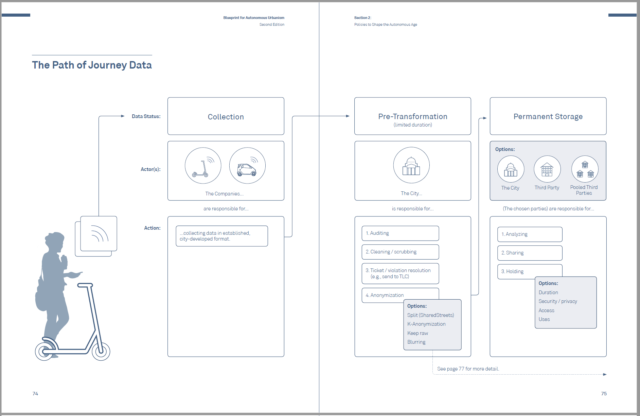Each day, billions of detailed, street-level data points are collected on everything from traffic speeds and volumes to travel patterns and transit use. The sheer amount of mobility data being collected daily has transformed data from a planning tool into an integral piece of infrastructure. Questions about this data —how it is collected, managed, protected, and stored, by whom, and for how long—are fundamental to managing an automated future. As consumers of data and protectors of the public interest, cities must prepare themselves to take on a strong role in data management and policy.
To prepare for AVs, cities should…
- Enhance Assets, Catalogue and Push Asset Data
Cities should catalogue their asset data and update street infrastructure so that they can push out real-time information about how streets are used (e.g., road closures, route restrictions, parking occupancy, delivery zone use, etc.). Cities can strategically partner with companies to implement counters and sensors. In some cases, the data collected by AVs themselves could be used to populate and maintain asset datasets. By taking an active approach to asset data, cities can guide the autonomous future in powerful ways.
- Focus on Open Data Specifications & Interoperability
Open data standards are a critical precursor to successful collaboration between the public and private sectors. As the number of data tools on the market proliferate, cities face a real risk of getting locked into proprietary tools if they do not prioritize open data. Cities should review development and procurement policies to ensure that open data is a prerequisite whenever possible, and support efforts to create open standards and specifications.
- Enhance and Update Data Management Policies
The rapidly growing volume and breadth of that data means that cities must proactively ensure that their data management policies are up to date. As discussed in the NACTO/IMLA Managing Mobility Data guidance, cities should ensure that journey data is classified as personally identifiable information and treated as such in policies around management, storage, dissemination, and use. Cities should ensure that their data policies and practices are routinely updated and should encourage responsible data management practice from mobility vendors operating in the public right-of-way.
- Build Up In-House Data Capacity
Cities should build up internal staff capacity to analyze and manage data so they can evaluate the quality of the data they receive from private vendors and push out asset data more readily. In addition to augmenting software expertise to handle analysis, cities should develop internal staff capacity around key skill or expertise areas such as data management, statistics, auditing, and fraud detection.
- Control the Means of Communication
The autonomous future will require a host of short- and long-range communication systems. Cities should prepare by developing policies to manage communications hardware in the public right-of-way, pushing back on federal preemption legislation, and supporting efforts to restore net neutrality, to ensure that everyone has the ability to participate. City-owned infrastructure like utility poles and street lights are increasingly at the center of debates about access, as 5G technologies, which are expected to be the future of communications, rely on a large number of small access points (vs. the smaller number of large cell towers that support existing networks). Control over siting for this equipment will shape the landscape of communications and the autonomous future.
- Coordinate for Privacy
Unlike Europe, the U.S. lacks comprehensive consumer privacy protection policies that guide how data is collected, stored, used, and shared. Already, ride-hail and shared micromobility companies have exploited this policy vacuum to lobby states and the Federal Government to limit the ability of local governments to require data. Cities should coordinate with States and consumer protection groups to advocate for stronger consumer data protection laws, such as the GDPR in Europe.
Policies to Shape the Autonomous Age

Download the Blueprint: